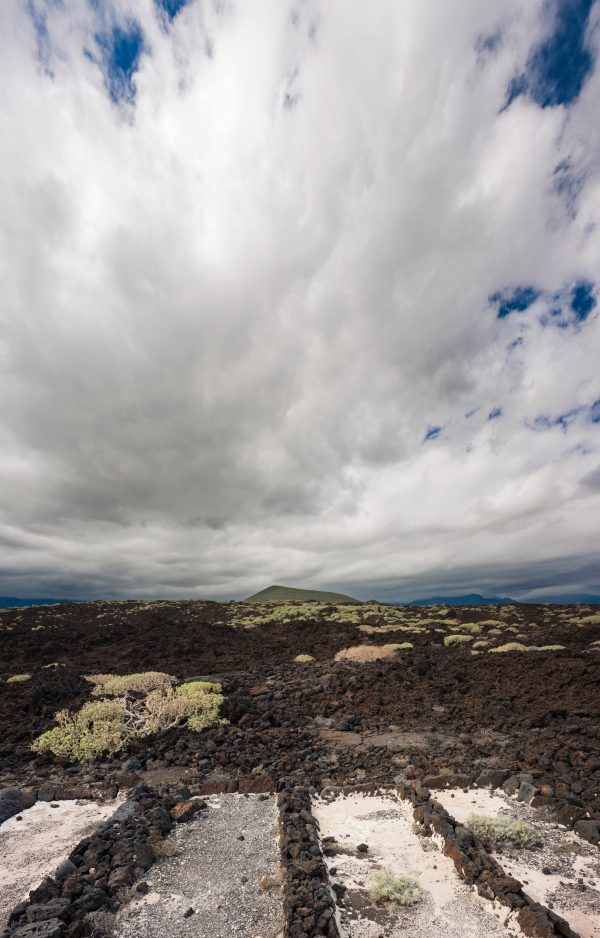I hold on tight in the back seat of the 4x4 pickup as the two potato farmers in front bring me ever higher up the volcanic slopes of Tenerife, the largest of Spain’s Canary Islands.
We pass rows of terraced fields cut into the steep mountainside and pull over at about 3,000 feet above sea level. It’s my last stop of a three-day exploration of salt-boiled papas arrugadas, a rustic finger food that to the uninitiated just looks like a bowl of dusty, bite-sized potatoes. Of course, they are so much more.
The fields are empty but for the rust-colored earth, resting until the seeds are replanted later in the winter. But we get out to take in the view. Base jumpers on a nearby outcropping let the trade winds lift their parachutes away from the hillside, and they float out over the glittering Atlantic. From our vantage, we are both above and below layers of clouds, and fog is approaching.
“At this altitude here, the clouds are always with us,” says Anatolio Luis Dominguez. “They water the plants, and the potatoes take what they need from the clouds.”
It’s a fitting description for papas arrugadas, which are so revered in the Canary Islands that people often talk about them as if the potatoes were self-aware.
To be clear, papas arrugadas, which translates simply as wrinkled potatoes, are a textbook exercise in simplicity done right. A dish born of necessity in the centuries before tourists found the black sand beaches on this subtropical playground. Back when every home had a garden, cooks washed pots of potatoes in the ocean, then boiled them in sea water. The water would evaporate, leaving behind a white film of salt on the slightly wrinkled skins.
These days few people use sea water for papas arrugadas, and what was once a staple for poor islanders now is the most common item on menus throughout the Canaries. They usually come with two mojos—or dipping sauces, one red, one green—that combine ingredients brought to the islands over the centuries by the Spanish, like sunflower oil, with European standards, like garlic. The red, a tangy puree of chilies, saffron and paprika, is rich and pungent, spicy and a little sweet. The green, a mash including cilantro, parsley and almonds, is herbal and bright, fresh and cooling.
They sometimes show up on dinner plates as a side, such as with the fried whole octopus I had one night. But they’re usually served as a snack, from beachfront shacks to five-star resorts.
“It’s the only thing that I must put on the menu,” says César González, executive chef of the cliffside El Mirador, a Bali-chic restaurant under a thatched roof on the southern coast.
Like others raised on Tenerife, González swears by one kind of potato, the papa bonita. He tells me the best come—of course—from his hometown, Icod de Alto, specifically from Dominguez and the other members of the Association of the Papa Bonita.
Which is how I find myself heading from the island’s arid south, around the 12,000-foot Mount Teide, to meet the potato farmers on the lush northern side. The road veers uphill through a series of hairpin turns, and my GPS directs me through a farm on a dirt shortcut so steep I fear my rented 4-cylinder stick shift will tumble backward. I manage to reach the road again and park outside the association’s two-room office. It’s noticeably colder than at the resorts on the coast.
Dominguez, the association’s president, and Judith Delgado, its secretary and his girlfriend of 15 years, come outside to greet me. “You went up that road? In that car?” Delgado hoots as she ushers me inside the pink cinderblock building. A few other famers are gathered around a circular table. A bowl of red mojo is waiting, as well as six empty wine glasses.
Delgado points out shelves filled with mesh sacks of different varieties of papas bonitas, or “pretty potatoes.” Each has a fanciful name. Black lily. Egg yolk. Partridge eye. But none is particularly attractive—irregular nuggets of varying shades, most just smaller than a golf ball, pitted with cracks and divots in splotchy skin.
In a kitchenette off to the side, Delgado dumps a bag of partridge eye bonitas into a pot, unceremoniously adds a couple handfuls of coarse sea salt and pours in a few glugs of water from a 5-liter jug.
"The potato takes the salt that it needs. It knows exactly how much,” she says, repeating a line I’ve heard before about the all-knowing tuber. There’s a whiff of scientific basis to that (see sidebar), and Delgado assures me the technique works on any small, firm potato (papas bonitas aren’t available in the United States; Milk Street's recipe calls for fingerlings or Yukon Golds, both fine substitutes).
As the potatoes cook, Delgado fills our glasses with Tenerifan wine—known to mainland Europe as far back as Shakespeare, who referenced it in “Twelfth Night.” The farmers extol the wonders of their potatoes, which they say stay fresh six months after harvest. They tell me about island life, and about the Calima, an occasional haze of sand that blows over from the Sahara, which ends at the African coast about 200 miles to the east.
After 20 minutes, Delgado drains the water and returns the pot to the heat, tossing the potatoes to disperse the remaining moisture. We start picking at them too soon, dipping them in the fiery mojo and burning our mouths.
The potatoes have been transformed from gnarly lumps, now boasting skin that snaps between my teeth like taut sausage casing, releasing a custardy snack whose buttery yellow flesh feels like a firm, unsweetened flan. I find myself craving the cooling green mojos I’d had elsewhere. We nibble and sniff, talking about the potatoes like wine. Everyone picks up faint aromas of chestnuts, and someone smells fresh butter. I taste egg yolk.
Somehow, they’re not intensely salty. Instead, they’re satisfying, and so addictive that we plow through a few pounds in less than 10 minutes. I finally get why they’re so revered.
Dominguez notes that this kind of respect for something so simple has been centuries in the making. Papas bonitas have been cultivated in Icod de Alto since conquistadors brought them back from Peru in 1622.
“When the conquistadors arrived, the potatoes were hidden,” he says. “The Incas said, ‘Take all the gold you want. This is the real treasure.’”

You'd think that potatoes cooked in heavily salted water—as for papas arrugadas—would taste overwhelmingly salty. But in the Canary Islands, where the dish originates, locals often say potatoes “know” how much salt they need, seasoning themselves with just enough to be delicious. Turns out, the old wives' tale is partly true.
Potato skin consists mostly of insoluble fiber, which is made up of polymers that act as an impenetrable canvas protecting the starchy flesh inside. The electrically charged ions in the salt can't penetrate the skin, impeding the salt from getting inside (nicks and imperfections in the skin obviously change this).
This means the salt should only affect the skin. As the potato boils, the salt draws water out of the skin through osmosis, shrinking it and causing it to wrinkle slightly. Once the water is drained and the moisture evaporates off the skin, some salt stays behind, seasoning the potato with a fine, white crust.
Except that when we did side-by-side tastings of potatoes boiled in plain water vs. salt, we noticed a difference inside, too. The flesh of the saltwater potatoes was creamier and more tender.
That's because saltwater boils at a higher temperature than plain water—220°F compared to 212°F for unsalted. The higher heat means the potato flesh cooks more completely, producing creamier results.
Related Recipes
March-April 2018

Sign up to receive texts
Successfully signed up to receive texts!
We'll only send our very best offers - Like a $15 store credit to start.
By entering your phone number and submitting this form, you consent to receive marketing text messages (such as promotion codes and cart reminders) from Christopher Kimball's Milk Street at the number provided, including messages sent by autodialer. Consent is not a condition of any purchase. Message and data rates may apply. Message frequency varies. You can unsubscribe at any time by replying STOP or clicking the unsubscribe link (where available) in one of our messages. View our Privacy Policy and Terms of Service.



